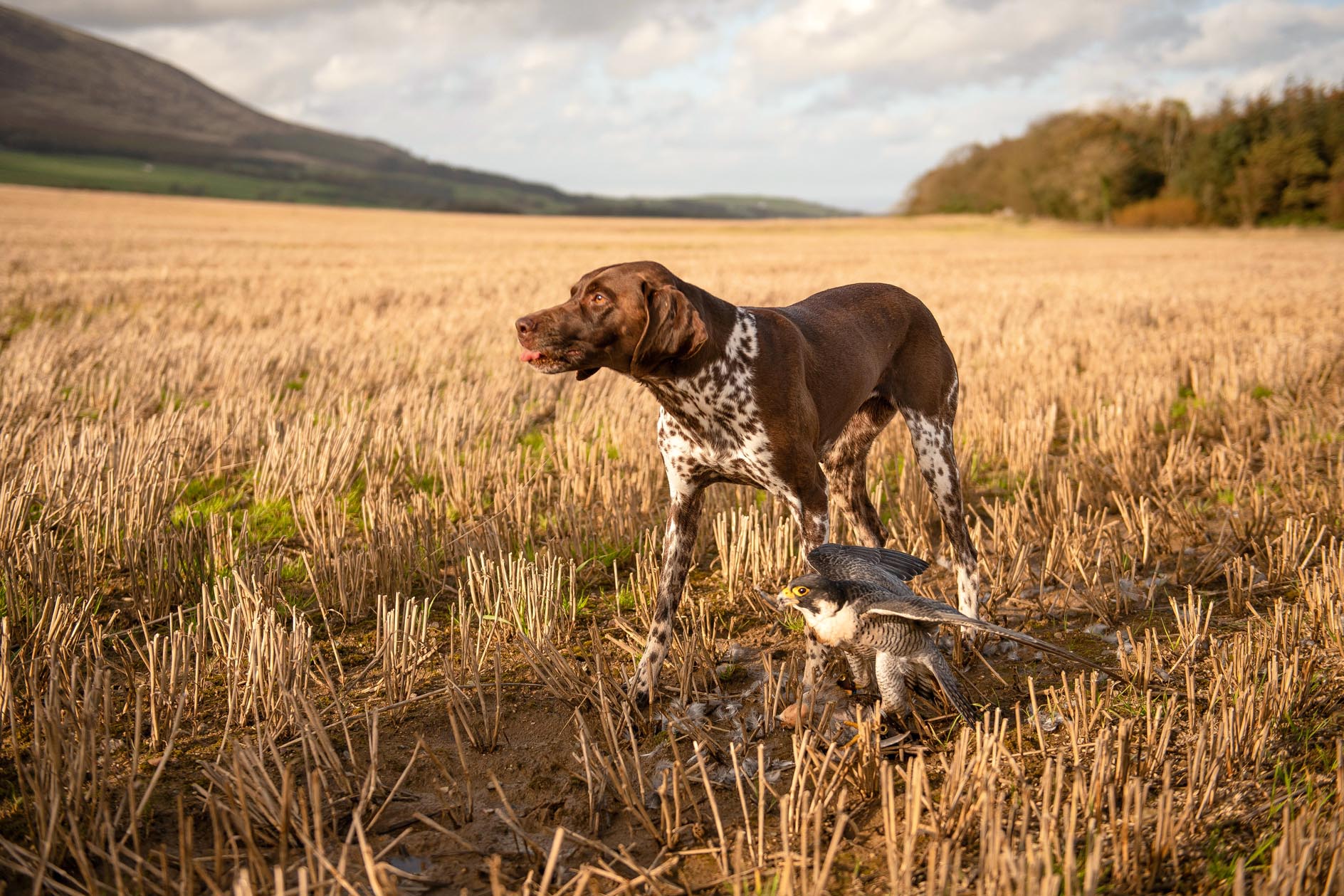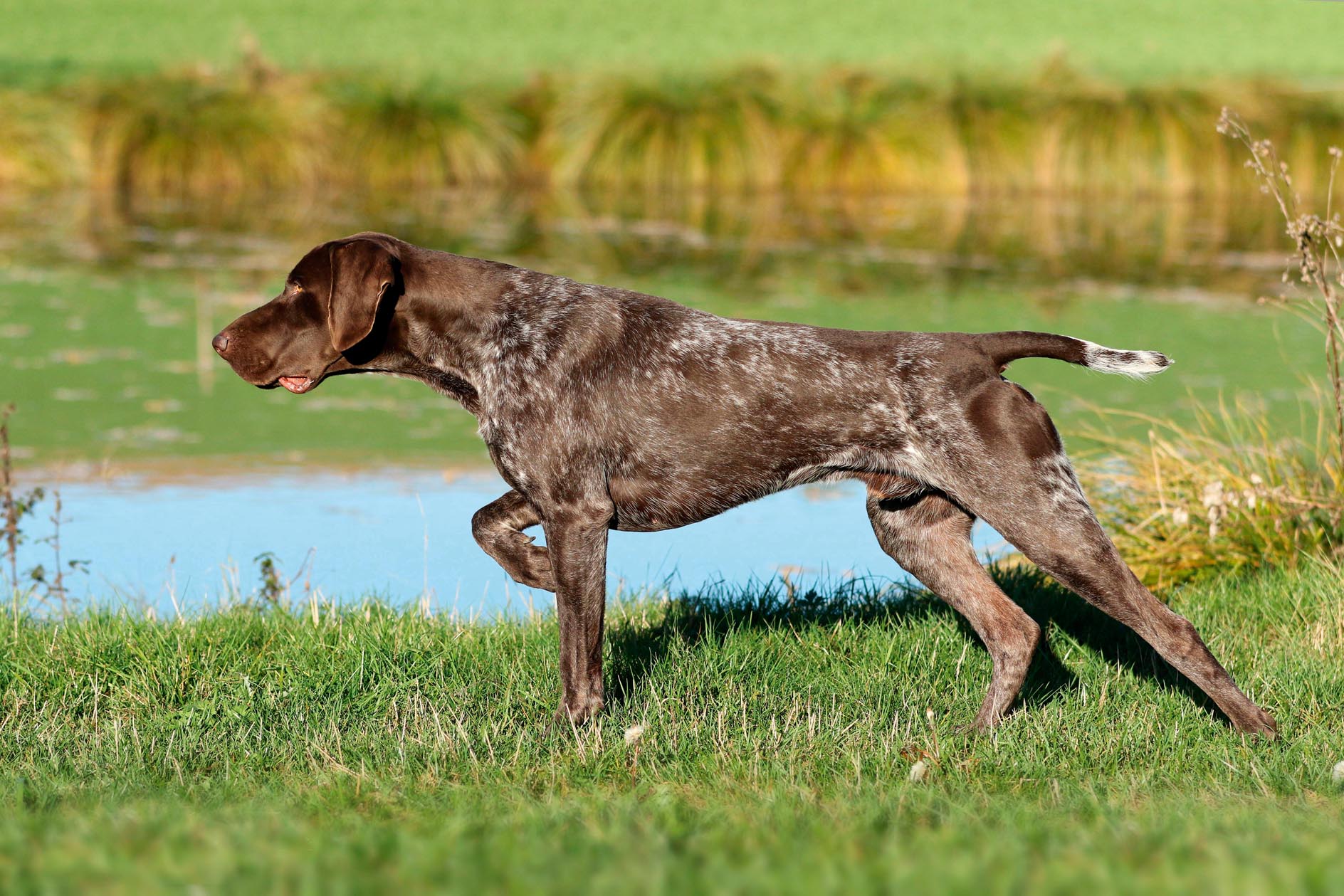German Shorthaired Pointers: The USPs of GSPs, perhaps the ultimate all-round dog
German shorthaired pointers will run for miles when you need them to, but curl up on the sofa when you want them to. Owner and convert Arabella Byrne explains her love for this strong, graceful breed.


‘And suddenly I see that some tremendous emotion has seized him, body and soul. His short bobbed tail begins to wave furiously. His head lunges forward... his body stretches and extends itself. He jumps hither and thither, and the next moment, with his nose still glued to the ground, he goes darting off. He has struck a scent. He is on the spoor of a rabbit.’
Thus wrote Thomas Mann in 1918 about his German shorthaired pointer (GSP), Bashan, in his little-known memoir Bashan and I. His dog is not alone in being seized by ‘tremendous emotion’. Mann’s memoir is an ode to an extraordinary breed, a love letter to a peculiarly singular line of dog. Arrestingly handsome, GSPs are noble of head with a graceful outline, long, sloping shoulders and a deep chest. Like all things German, the GSP is built for efficiency: with its keen, aquiline nose, it can hunt, point and retrieve simultaneously, assisted by the strength and power of the hindquarters.
Equally good on land and water, GSPs — if well trained — are the ultimate all-rounders. Like the stylish and sleek Audi, GSPs look good, act slick and can go the distance. It’s all down to whether or not you fancy having a large German lolling about on your sofa.

The breed characteristics are hollow without the colour of the pedigree’s history, one that straddles the rise of the Prussian middle class, both World Wars and certain Anglo-German historic contours. Originating in Germany in the 19th century, the GSP was borne of the increase in wealth and the rise of the middle-class landowner in the Prussian Empire. As vast swathes of Teutonic forest and plain began to be passed from the nobility to the merchant class, the need for an all-round hunting dog grew. Yet breeding for the aesthetic and functional perfection the German bourgeoisie wanted was never going to be easy. Early exemplars are thought to be a cross between a range of different pointers: Spanish, old German and French Braque Français. This confection needed more nuance to iron out the problems in temperament that emerged from the aggregation of such powerful animals. Cue the introduction into the bloodline of English pointers and bloodhounds and the GSP was born.
Initially known in their native land as the Deutsch Kurzhaar, the first GSP was recorded in the German Kennel Club book in 1872. At about the same time, Prince Albrecht zu Solms-Braunfels was setting down regulations for the breeding and testing of the modern German hunt, point, retrieve (HPR) breeds, assuring their aristocratic status.
Still, it took more than 10 years for the breed to take off seriously and spread its wings beyond its forested homeland. For this serendipitous fact we may thank Nero and Treff, GSPs that allegedly competed in the German Derby of 1883, becoming the foundation dogs of the breed in America (where GSPs continue to enjoy huge popularity) and beyond. For the dog to make it over the Channel in the aftermath of the Second World War, the facts — rather than the association — had to do the talking. Spotted by British troops posted to Germany, the GSP soon won them over with its ability to work and sheer efficiency.

In today’s Britain, however, these dogs are a rare sight. As the proud owner of Percy, a three-year-old GSP, I can attest to the attention they attract, often for a mixture of reasons if there are birds about. Mann again: ‘There are few things which are able so to refresh my eyes as the sight of him, as he goes sailing through the underbrush in a light, feathering trot and then suddenly stands at gaze, with one paw daintily raised and bent inward, sagacious, vigilant, impressive.’
This is, of course, the celebrated point, nothing short of balletic when seen at close range: tail horizontal to snout, movement stilled, one front paw raised and folded in breathless anticipation. However, such finesse must be trained or suffer the consequences, as long-time breeder and judge Maureen Nixon notes: ‘They are good-looking dogs, but obedience is crucial. Creating a firm routine and setting expectations is essential; they will take as much exercise as you give them.’
Exquisite houses, the beauty of Nature, and how to get the most from your life, straight to your inbox.
More pointers
- The Italian pointer, or Bracco Italiano, has the oldest lineage, dating back to the 5th century in the Piedmont region
- The Spinone Italiano takes its name from the thorny spino undergrowth it negotiated when hunting in northern Italy
- The French pointer, known as Brittany, was bred to hunt the fertile land in northern France in the 1600s. Similar to spaniels, these dogs are compact and agile
- The English pointer (referred to simply as a pointer) has a squarer head than his German counterpart, but possesses the same outstanding field abilities and calm temperament
- The German shorthaired pointer, as does its wirehaired and longhaired compatriots, has webbed feet and is a strong swimmer
Jo Izard, who works GSPs, is also a strong believer in deploying a firm hand. ‘The hardest thing is to make them work for you,’ she explains. ‘They have a tendency to run in, but the thing to do is start with them on a long line and never let them run in in the first place. You have to be committed, but it is worth it. They are so impressive to watch.’
At home, GSPs are extremely companionable dogs that like nothing better than to be en famille, enjoying sofa and even bed privileges. Often given a bad press for their highly strung temperament, with the right amount of exercise (a minimum of three miles per day, plus the occasional drenching in a river) and stimulation, they are calm and biddable members of the household. If said household includes small children or babies, GSPs make superb family dogs thanks to their preference for non-stop company and champion attendance at the high chair for falling scraps from little hands — although they do not exhibit anything like a labrador level of greed. In my house, where several small children frequently gather, constantly munching at snout-level, Percy is calm and stolid, periodically escaping to a distant bedroom to flee the noise — and, frankly, who could blame him?
Bella Roberts, whose GSP Coco moves between the Cotswolds and Belgravia, often jumping the gates in Belgrave Square Gardens — as documented on her Instagram account @cocoandlilyofbelgravia — vouches for their flexibility moving between town and country: ‘As a breed, they’re very obedient in the car and at home, if they’ve been properly exercised.’ Note carefully the ‘if’; without the requisite attention or exercise, they will make their presence felt rambunctiously.
If anyone knows anything about having GSPs underfoot, it is Sir Michael Leighton, 11th Baronet of Loton Park, Shropshire. Having had a dozen, including what he calls the ‘Prussian Blues’ (for their markings), since the age of 23, Sir Michael describes them as the ultimate all-round working dog, able to hunt out prey where spaniels and labradors can’t.
As he’s an acclaimed poet, I asked if he had ever dedicated a stanza to his lifelong companions. ‘They were simply too close to me; they were my life,’ he says, poignantly. I understand him perfectly; for all the speed, efficiency and distance scaled across forbidding terrain, a GSP is always close by, tethering himself to the heart of his owner. Mann was right — when it comes to a GSP, there is tremendous emotion.


English pointers: The dogs that are full of energy and fun, with a history that includes one of the great canine heroes of the Second World War
In the latest instalment of our series on Britain's favourite dogs, we get to know the impressively versatile English pointer

Credit: Daniel Gould / Country Life Picture Library
Britain's Naughtiest Dog 2019: All the winners, from the Jack Russell who summoned the armed police to the pointer who vomits glitter
Sociable, sun-loving and incredibly patient with children, this innocent-looking Jack Russell actually enjoys a secret life of crime. Victoria Marston
Country Life is unlike any other magazine: the only glossy weekly on the newsstand and the only magazine that has been guest-edited by His Majesty The King not once, but twice. It is a celebration of modern rural life and all its diverse joys and pleasures — that was first published in Queen Victoria's Diamond Jubilee year. Our eclectic mixture of witty and informative content — from the most up-to-date property news and commentary and a coveted glimpse inside some of the UK's best houses and gardens, to gardening, the arts and interior design, written by experts in their field — still cannot be found in print or online, anywhere else.
